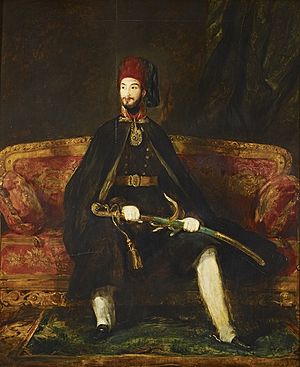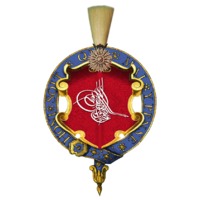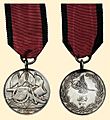Abdülmecid I facts for kids
Quick facts for kids Abdulmejid I |
|||||
|---|---|---|---|---|---|
| Ottoman Caliph Amir al-Mu'minin Custodian of the Two Holy Mosques Khan |
|||||
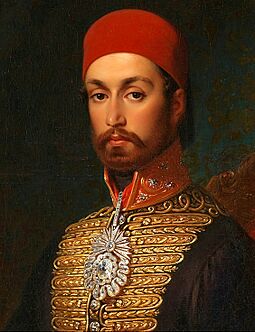
Portrait by Konstantin Cretius
|
|||||
| Sultan of the Ottoman Empire (Padishah) | |||||
| Reign | 2 July 1839 – 25 June 1861 | ||||
| Predecessor | Mahmud II | ||||
| Successor | Abdulaziz | ||||
| Grand Viziers |
See list
Husrev Pasha
Sadık Rıfat Pasha Mehmed Emin Rauf Pasha Ibrahim Sarim Pasha Topal Izzet Mehmed Pasha Mustafa Reşid Pasha Mehmed Emin Âli Pasha Damat Mehmed Ali Pasha Mustafa Naili Pasha Kıbrıslı Mehmed Emin Pasha Mehmed Rushdi Pasha |
||||
| Born | 25 April 1823 Constantinople, Ottoman Empire |
||||
| Died | 25 June 1861 (aged 38) Constantinople, Ottoman Empire |
||||
| Burial | Yavuz Selim Mosque, Fatih, Istanbul | ||||
| Consorts | Servetseza Kadın Şevkefza Kadın Tirimüjgan Kadın Verdicenan Kadın Gülcemal Kadın Gülistu Kadın Rahime Perestu Kadın Bezmiara Kadın Mahitab Kadın Düzdidil Hanım Nükhetseza Hanım Zeynifelek Hanım Nesrin Hanım Ceylanyar Hanım Serfiraz Hanım Nalandil Hanım Navekimisal Hanım Nergizev Hanım Şayeste Hanım Others |
||||
| Issue Among others |
See
|
||||
|
|||||
| Dynasty | Ottoman | ||||
| Father | Mahmud II | ||||
| Mother | Bezmiâlem Sultan | ||||
| Religion | Sunni Islam | ||||
| Tughra |  |
||||
Abdülmecid I (born April 25, 1823 – died June 25, 1861) was the 31st sultan of the Ottoman Empire. He became sultan on July 2, 1839, after his father, Mahmud II, passed away. His time as ruler is remembered for big changes and new ideas across the empire.
One of Abdülmecid's most important actions was starting the Tanzimat Edict when he became sultan. This was a major plan to modernize the Ottoman Empire. He worked with smart advisors to bring in new laws and improve how the empire was run. These changes aimed to make all people, including non-Muslims, feel more like part of the Ottoman society.
He also made strong friends with powerful countries in Western Europe, like the United Kingdom and France. They even fought together against Russia in the Crimean War. After this war, the Ottoman Empire became an official member of the "Concert of Europe," which was a group of major European powers. His half-brother, Abdulaziz, became the next sultan after him.
Contents
Early Life and Learning
Abdülmecid was born in Istanbul, the capital of the Ottoman Empire, on April 25, 1823. His mother was Bezmiâlem Kadın.
He was the first sultan to get a European-style education. He even learned to speak French very well. Like his brother Abdülaziz, he enjoyed reading and listening to classical music.
His Time as Sultan
Challenges at the Start
When Abdülmecid became sultan in 1839, he was only sixteen years old. The Ottoman Empire was facing big problems. The army had just lost a major battle against Muhammad Ali, the ruler of Egypt. Also, the Ottoman navy had been given to Muhammad Ali.
However, other European countries stepped in to help. They made Muhammad Ali agree to a peace deal. This saved the Ottoman Empire from further attacks and helped it get back control of lands in Syria, Lebanon, and Palestine.
Big Changes: The Tanzimat Reforms
Abdülmecid believed in making big changes, just like his father. He had smart advisors who helped him. He was also the first sultan to listen directly to people's complaints on special days. He even traveled around the empire to see how the new reforms were working.
On November 3, 1839, a very important document called the Edict of Gülhane was announced. This document promised to protect everyone's lives and property. It also said that taxes would be fair and justice would be given to everyone, no matter their religion. All citizens would have equal rights.
These changes faced some resistance from traditional groups. But many important reforms still happened:
- The first banknotes were created.
- The Ottoman lira currency was introduced.
- The financial system was updated.
- Plans were made to end slave markets.
- Non-Muslims no longer had to pay a special tax and could join the army.
- New civil and criminal laws were created, similar to those in France.
- Modern universities and schools were opened in 1848.
- The army was reformed, and a new conscription system was started.
- In 1844, a new Ottoman national flag and anthem were adopted.
- The turban was officially replaced by the fez as the official headwear.
Foreign Relations and the Crimean War
Abdülmecid showed courage when Lajos Kossuth, a Hungarian leader, sought safety in the Ottoman Empire. Austria and Russia demanded that Abdülmecid hand him over, but he refused.
There's a story that Abdülmecid wanted to send a lot of money to help Ireland during its Great Famine. He planned to send £10,000, but it was reduced to £1,000. This was done so he wouldn't give more than Queen Victoria of the United Kingdom, who had donated £2,000.
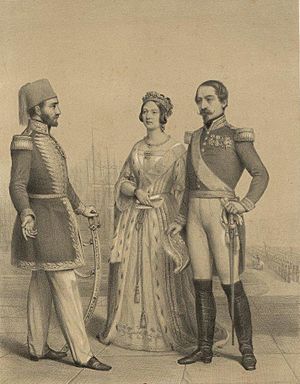
The Crimean War and Its Results
On October 16, 1853, the Ottoman Empire went to war with Russia. This war became known as the Crimean War. Soon, France and Britain joined the Ottoman side. The Ottomans and their allies won the war.
After the war, the Ottoman Empire signed the Treaty of Paris (1856). This treaty brought the empire into the "Concert of Europe," a group of powerful European nations. To please these powers, Abdülmecid issued another reform edict in 1856.
During the war, the Ottoman Empire took its first foreign loans. More loans followed, which later caused financial problems. These money troubles eventually led to his brother Abdülaziz being removed from power.
The empire also faced challenges in the Balkans. In 1861, Abdülmecid had to give up control of Lebanon, creating a special area called the Mount Lebanon Mutasarrifate.
The financial problems and the growing influence of European countries caused unhappiness. Some people even tried to overthrow Abdülmecid in 1859, but the plot was stopped.
Building Projects
Abdülmecid loved building and modernizing. He moved the royal family out of the old Topkapı Palace, which had been used for four centuries. He built the new, European-style Dolmabahçe Palace. This palace cost a lot of money, but it was a grand symbol of the empire's modernization.

He also ordered repairs to the famous Hagia Sophia mosque. Other important buildings from his reign include:
- Beykoz Pavilion (1855)
- Küçüksu Pavilion (1857)
- Küçük Mecidiye Mosque (1849)
- Teşvikiye Mosque (1854)
- The new Galata Bridge (1845)
Death
Abdülmecid died from tuberculosis on June 25, 1861, in Istanbul. He was 38 years old. He was buried in the Yavuz Selim Mosque. His younger half-brother, Abdulaziz, became the next sultan.
Personality
Abdülmecid was known as a kind and honorable person. He was sometimes seen as a bit weak or easily influenced. However, he was also known for spending a lot of money, especially towards the end of his life.
Honours and Emblem
Honours
 1851: Started the Order of the Medjidie;
1851: Started the Order of the Medjidie; 1856: Grand Cross of the Tower and Sword;
1856: Grand Cross of the Tower and Sword; 1856: Stranger Knight of the Garter;
1856: Stranger Knight of the Garter; 1860: Grand Cordon of the Order of Leopold;
1860: Grand Cordon of the Order of Leopold; Grand Cross of the Legion of Honour.
Grand Cross of the Legion of Honour.
Garter Emblem and Arms
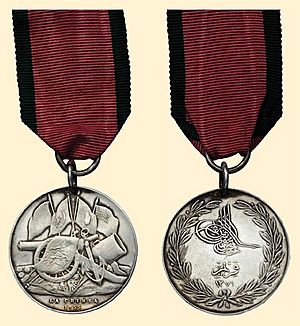
Family
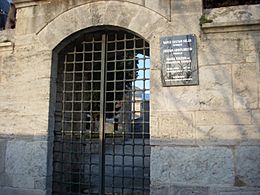
Abdülmecid had many children. He was the first sultan whose royal household was not mainly made up of enslaved women. Instead, it included women from free, noble, or wealthy families.
Sons
Abdülmecid had many sons, including three who later became sultans:
- Murad V (1840 – 1904) – 33rd Sultan.
- Abdülhamid II (1842 – 1918) – 34th Sultan.
- Mehmed V Reşad (1844 – 1918) – 35th Sultan.
- Mehmed VI Vahideddin (1861 – 1926) – 36th and last Sultan.
Daughters
Abdülmecid had many daughters, including:
- Fatma Sultan (1840 – 1884)
- Refia Sultan (1842 – 1880)
- Cemile Sultan (1843 – 1915)
- Münire Sultan (1844 – 1862)
- Behice Sultan (1848 – 1876)
- Seniha Sultan (1851 – 1931)
- Mediha Sultan (1856 – 1928)
- Naile Sultan (1856 – 1882)
See also
 In Spanish: Abdülmecid I para niños
In Spanish: Abdülmecid I para niños
Images for kids


